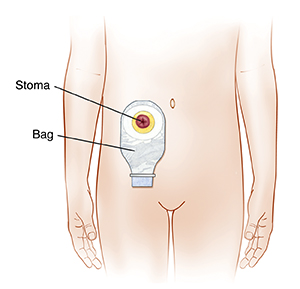When Your Child Needs a Stoma
If your child has a problem that affects their intestine, they may need a stoma. A stoma or ostomy is an opening that’s made on the belly (abdomen) for the discharge of body wastes. The intestine is attached to this new opening. It gives a new way for stool and mucus to leave the body. It’s important to help care for your child’s stoma at home. You can help your child adjust to having a stoma.
How does a stoma work?
During surgery, the colon or part of the small intestine (ileum) is removed or cut. A small opening is made in the wall of the belly (abdomen). The end of the intestine is attached to this opening. The end of the intestine is folded like a small cuff. This is the stoma.
To make a stoma, the surgeon may use 1 end of the bowel, a loop of the bowel, or both ends of the bowel. Waste (stool and gas) then leaves the body through the stoma. It empties into a bag. You will be taught how to care for this.
 |
| A stoma allows stool and mucus to leave the body and empty into a bag. |
Why is a stoma needed?
A stoma is needed if your child has a problem with their intestine. This problem may be due to:
-
A health problem at birth (congenital), such as intestinal malrotation
-
An illness that affects the intestine, such as diverticulitis, ulcerative colitis, or Crohn's disease
-
An injury or surgery that affected the intestine
A stoma is temporary when it’s used to let the intestine heal after illness or surgery. A stoma is permanent when the intestine is damaged or a large part has been removed.
Caring for your child
Before you and your child leave the hospital, you’ll be given home care instructions. You may meet with an ostomy nurse. You’ll need to help your child care for the stoma and the skin around it. Follow all instructions given by your child’s healthcare provider and ostomy nurse. Make sure to:
-
Keep the stoma and the skin clean. Protect the skin from moisture and contact with stool. This helps to prevent skin soreness and wounds. Clean the skin around the stoma with warm water, mild soap, and a washcloth. Pat dry after cleaning.
-
Empty the stoma bag regularly. This is usually needed after every bowel movement. Get familiar with your child’s bowel habits. Learn the amount and texture of stool that’s normal for your child.
Helping your child live with a stoma
The stoma shouldn’t cause pain for your child. But it may take some time for them to get used to it. You can help your child by encouraging them to go back to a normal routine.
-
Your child can be active like other children. Check with your child’s healthcare provider about what physical activities are OK for your child.
-
Your child can go back to a normal diet unless told not to by the healthcare provider.
-
Your child can wear the same clothing as before. Stoma bags are designed to lie flat against the body. The bag can fit under clothes where no one sees it.
-
Meet with your child’s caretakers or teachers and speak with them about your child’s needs. Make sure they know how to contact you or your child’s healthcare provider in case of a problem or emergency.
-
Keep extra care supplies for your child’s stoma at home and at school.
When to call the healthcare provider
Contact the healthcare provider right away if your child has any of these:
-
Skin around the stoma that is red, oozing, bleeding, or broken
-
Skin around the stoma that itches, stings, or has white spots
-
Stoma that swells, changes color, or bleeds without stopping
-
Stoma that becomes flat or sinks below the skin, or sticks out more than usual
-
Cramping or abdominal pain
-
Bowel movements that are more watery or that occur less often than usual
-
Bloody or black stool
-
Fever of 100.4°F ( 38.0°C) or higher, or as directed by the healthcare provider